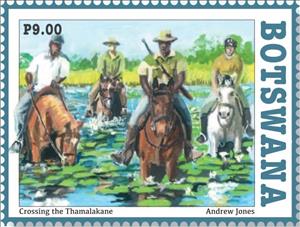Stamp: Crossing the Thamalakane (Botswana 2017)
Crossing the Thamalakane (Botswana 2017)
05 October (Botswana ) within release Crossing Rivers in Botswana goes into circulation Stamp Crossing the Thamalakane face value 9 Botswana pula
| Stamp Crossing the Thamalakane in catalogues | |
|---|---|
| Colnect codes: | Col: BW 2017-003 |
Stamp is square format.
The Thamalakane River is located at the southern end of the Okavango Delta in Botswana. It has no well-defned beginning (spring) and no clear end (delta). It is the result of the Thamalakane fault - which began to form about two million years ago by the geological process of rifting that is currently splitting Africa apart along the East African Rift.Also in the issue Crossing Rivers in Botswana:
- Stamp - Crossing the Limpopo face value 7;
- Stamp - Crossing the Thamalakane face value 9;
- Stamp - Crossing Molopo face value 10;
- Stamp - Crossing the Chobe face value 5;
- Souvenir Sheet - Crossing Rivers in Botswana face value 31;
|
Data entry completed
53%
|
|
|---|---|
| Stamp Crossing the Thamalakane in digits | |
| Country: | Botswana |
| Date: | 2017-10-05 |
| Print: | Offset lithography |
| Emission: | Commemorative |
| Format: | Stamp |
| Face Value: | 9 Botswana pula |
Stamp Crossing the Thamalakane it reflects the thematic directions:
Animals are multicellular, eukaryotic organisms of the kingdom Animalia (also called Metazoa). All animals are motile, meaning they can move spontaneously and independently, at some point in their lives. Their body plan eventually becomes fixed as they develop, although some undergo a process of metamorphosis later on in their lives. All animals are heterotrophs: they must ingest other organisms or their products for sustenance.
The horse (Equus ferus caballus) is one of two extant subspecies of Equus ferus. It is an odd-toed ungulate mammal belonging to the taxonomic family Equidae. The horse has evolved over the past 45 to 55 million years from a small multi-toed creature, Eohippus, into the large, single-toed animal of today. Humans began to domesticate horses around 4000 BC, and their domestication is believed to have been widespread by 3000 BC. Horses in the subspecies caballus are domesticated, although some domesticated populations live in the wild as feral horses. These feral populations are not true wild horses, as this term is used to describe horses that have never been domesticated, such as the endangered Przewalski's horse, a separate subspecies, and the only remaining true wild horse. There is an extensive, specialized vocabulary used to describe equine-related concepts, covering everything from anatomy to life stages, size, colors, markings, breeds, locomotion, and behavior.
A river is a natural freshwater stream that flows on land or inside caves towards another body of water at a lower elevation, such as an ocean, lake, or another river. A river may run dry before reaching the end of its course if it runs out of water, or only flow during certain seasons. Rivers are regulated by the water cycle, the processes by which water moves around the Earth. Water first enters rivers through precipitation, whether from rainfall, the runoff of water down a slope, the melting of glaciers or snow, or seepage from aquifers beneath the surface of the Earth.



